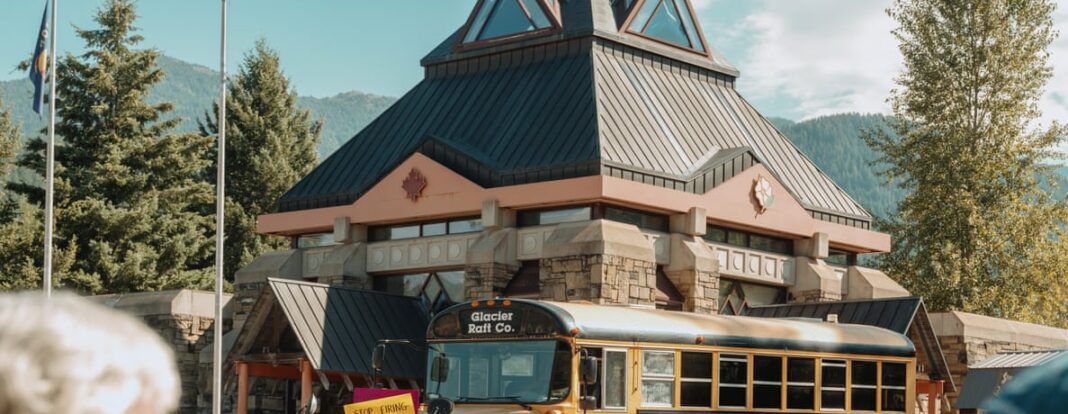Dozens of former rangers, park volunteers, and local residents protested at the gateway to Montana’s Glacier national park on Wednesday against the staff cuts and hiring freezes that have thrown many national parks into crisis, including Glacier.
Current and former staffers and watchdog groups say the cuts have meant staff are not able to keep up the facilities and infrastructure. Some say the park has been left with inadequate infrastructure and too little staff to be able to respond to emergencies.
Although it might look to visitors like operations in Glacier are normal, “it’s like walking down a Hollywood movie set where the front looks great but there’s nothing behind it,” said Sarah Lundstrum, Glacier program manager with the National Parks Conservation Association.
The protesters held signs, chanted and waved at tourists during a visit to the park from the Congressional Western Caucus. Hosted by Montana Republican congressman and former interior secretary Ryan Zinke, the caucus came to the park to showcase the success of the 2020 Great American Outdoors Act, which secured federal funding for protection and maintenance of public lands.
Montana’s Republican senator Steve Daines championed that bill during Donald Trump’s first term, calling it “the greatest conservation win for Montana and the entire country in 50 years”. In May, Daines introduced the America the Beautiful Act to extend federal funding for projects to address crucial maintenance backlogs.
But congressional support for funding projects in national parks comes at a jarring disconnect with the Trump administration’s slashing of jobs at national parks countrywide, including at Glacier, where an already overworked staff has been left with little to no bandwidth to implement projects.
No congressional Republicans, including Daines or Zinke, have spoken up against the cuts and freezes, and all voted for the One Big Beautiful Bill Act that rescinded $276m from the National Park Service (NPS).
“We’re supporting the park, but drawing attention to the fact our policymakers are grandstanding in a national park where behind the scenes they’ve gutted staff and gutted funding,” said Suzanne Hindler, one of the rally’s organizers. She said organizers specifically chose to hold the event outside the park to avoid adding more work for already overburdened park staff during peak tourist season.
Hindler emphasized that funding for national parks is crucial. But without the staff to execute the work, new problems will arise with no one to fix them, she said.
Jan Metzmaker, a longtime park employee who was on Glacier’s first all-women’s trail crew in the 1970s, said: “I can see the deterioration in the services and in the facilities.
“They really need to put some money into those, because this place is crazy with people. It’s being loved to death. But there’s no way that they can do the maintenance and all the things that need to be done in the park now.”
Visitation to national parks reached a record 331.9 million last year. But because of the Trump administration’s hiring freezes, terminations, and buyout and early retirement offers, US national parks have lost nearly a quarter of permanent staff, with seasonal hiring behind by nearly 8,000 positions. Further staff cuts, described as “deep and blunt” and “aggressive and swift” by National Parks Traveler, the multi-media outlet that covers NPS, are held up in court but may still be forthcoming.
In Glacier, which has seen a 7.5% increase in visitors from last year’s record high, the park is trying to operate with a 25% loss of staff. Vacancies span from chief ranger and fire positions, wildlife scientists, multiple environmental impact analysis positions, and emergency services, to mechanics, electricians, plumbers, and IT positions.
After the federal government canceled all national parks’ internet contracts this year, Lundstrum said, Glacier now uses StarLink, which some staffers say is spotty, goes down entirely, and often fails to connect park dispatch and 911 calls. There’s only one IT person remaining to address technical problems, those staffers, who asked to remain anonymous because they fear retaliation for speaking out, in a park that spans the Continental Divide, has no cell service, and regularly sees lost and injured hikers and encounters with wildlife, including the park’s dense population of grizzly bears.
On top of that, said a current park employee who spoke on condition of anonymity, there are no longer enough staff to safely respond to emergencies. It’s only luck “that the park hasn’t had any big events this year”, they said. “In past years we’ve had big fires, major search-and-rescue operations, really critical injuries. It’s only a matter of time until there’s an event we can’t respond to appropriately and there’s a mass failure of a system.”
And yet the interior secretary Doug Burgum issued an order in April requiring all parks to remain “open and accessible” despite the reduced staff. In Glacier, that might come at the cost of visitor and staff safety.
The department of the interior did not immediately respond to a request for comment on the concerns the staffers and watchdog groups raised. The offices of Zinke and Daines also did not respond to a request for comment.
The staffers say that remaining staff are doing “twice the job they used to”. Law enforcement are covering twice their previous area, maintenance workers are doing jobs they are not trained for, and outside recreation operators, such as Glacier Guides and Montana Raft, are emptying trash and cleaning bathrooms at river accesses to make up for the gaps. The mentality inside the park, said the employee, “is that if you’re the only one left, you’ll do whatever you can to help”.
The Association of National Park Rangers reported that “amid federal budget cuts, some seasonal employees at Yosemite national park worked for as long as six weeks without pay in recent months as park supervisors struggled to manage hiring”.
One of the rally attendees, a local woman named Kathy who asked not to be identified by her last name, is a volunteer with the Glacier National Park Association. “We do restoration, painting, backcountry patrol, visitor center, vehicle reservations. We want to do things, but unfortunately, we don’t have enough supervisors – rangers – to have volunteers.”
“It feels like the government is setting us up to fail,” said the Glacier employee.
Experts worry that Trump’s budget proposal to cut 36% of the national park budget, which could force the closure of up to 350 park units, is a deliberate attempt to sabotage the park system as an excuse to sell those lands for profit.
“Hollowing out staffing, cutting budgets, changing priorities – all of that very much lends itself to the idea of essentially causing those agencies to fail at meeting their mandates, and that will lead to the call for privatization,” said Lundstrum. “Because if the government can’t manage that land, then obviously somebody else should, right? In documents like Project 2025, there are calls for the privatization of land, or the selloff of land.”
Multiple sources say that morale among Glacier staff is low. “The civilian federal workforce used to be nonpartisan, so you always felt like you could have your opinion – liberal or conservative – without fear of retribution,” said one employee. “And now the undertone is to stay under the radar. If you speak up and say ‘this is wrong’, you pretty much have a target on your back.”
One young mother who came to the rally with her two small sons asked not to be identified because her husband is a federal employee; just this month, the justice department fired an official whose husband developed a phone app that tracked Ice agents.
“Having these two little guys is just a constant reminder of how much our world is changing, and the need to stand up for it. Everything could be gone in a blink,” the mother said.
Glacier is also the national park poster child for climate change, as its namesake glaciers are predicted to be completely gone in the coming decades. Yet the administration, without any pushback from congressional Republicans, has cut and scrubbed climate science and reversed Biden-era initiatives to curb climate change.
In his press release, Daines said he introduced the America the Beautiful Act “so that people can get outside and enjoy the natural beauty we’re lucky to have here in the US”, and that he was “proud” to “protect our outdoor way of life for generations to come”.
Hildner said she was not fooled. She said: “To see capitalism as the driving force for managing lands, rather than conservation, is really terrifying: for myself, for what it means for future generations, and what it means for the planet. How do we as a public help the folks who’ve been elected to govern see what the real costs are?”



